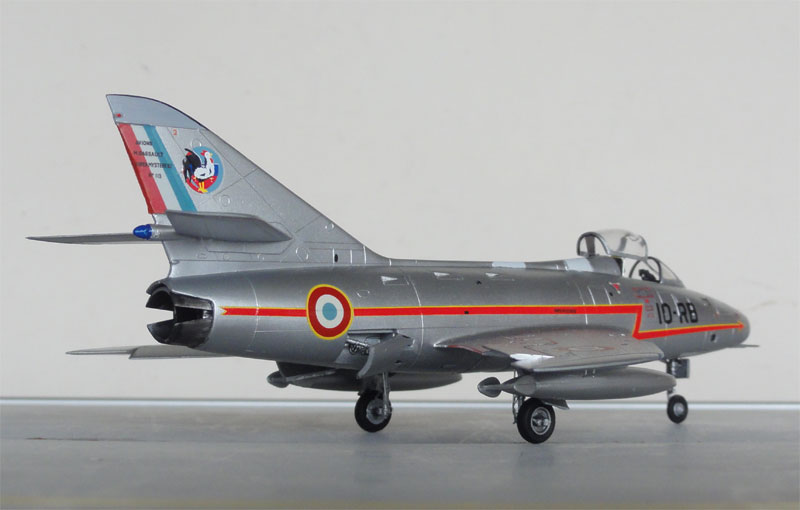/ Sa'ar / Sambad
1/72 scale kits of the Dassault Super Mystere
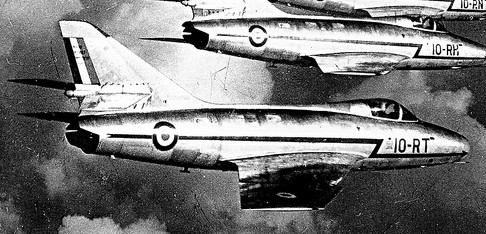
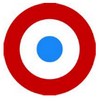
The Dassault Super Mystere was the successor of the Mystere of the nineteen fifties for the French Armee de L 'Air. It became an entirely different aircraft with a highly swept wing for higher speeds and also a larger oval nose intake. The Super Mystere was the first series-built West-European fighter that could achieve a supersonic speed in horizontal flight. It had a single SNECMA ATAR 101G engine installed with afterburner. Armament was two DEFA canons in the nose with some payload carried on pylons below the wings. The first prototype, the Super Mystère B.1 flew in March 1955 with a British Avon engine. The Super Mystere was made in some variants but the B2 was the most well known type and about 180 were made with the more powerful French SNECMA Atar 101G engine.
The French Air Force extensively used the aircraft and it was the primary interceptor of its day during the Cold War. The type was replaced in the early seventies by the swept shoulder winged Mirage F-1.
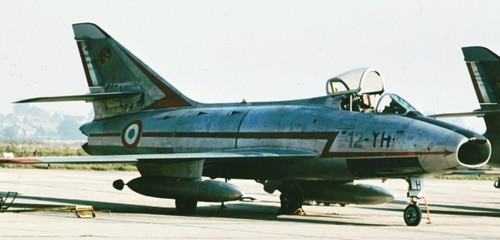
Some 24 Super Mystere aircraft were also sold to Israel and used in the 1968 "six day" war. These aircraft later got Pratt & Whitney engines with a longer jetpipe and new avionics. Later from 1975 some 16 Israeli Sa'ar aircraft were sold to Honduras (seen on page 2...).
page 2
The first Super Mystere model is an old Airfix
kit that was first released in 1972. It was decided to start with the older Airfix
model and to build it straight out of the box. 
The kit parts are basic, but the model
shape looks accurate.
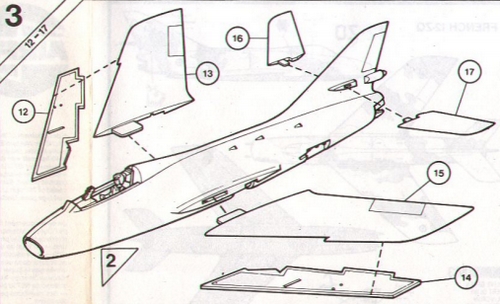
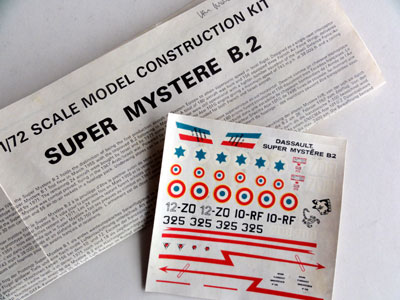
The decals are simple and were old,
this being an old box. Decals for 2 French and 2 Israeli air force aircraft are in the kit.
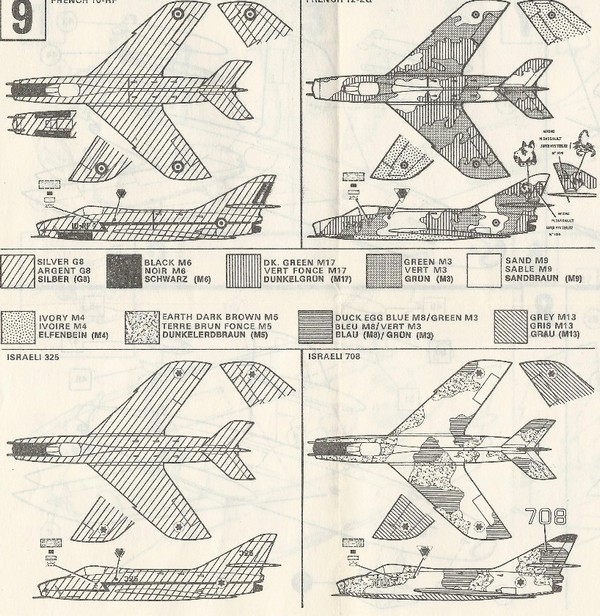
But new decals will come to the rescue. My friend Peter was doing the same and it looked quite nice despite its age with the raised panellines and lack of detail. Peter also had some spare BERNA decals left for my kit, so what was to stop modelling this kit?
OK, let us start the build.
![]()
The fuselage cockpit was kept simple,
just adding some details from plastic card like the side consoles
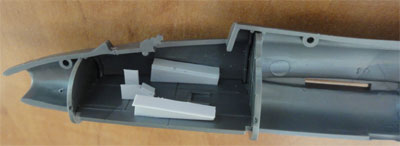
I did not bother to add an intake
duct, just painted the area black.
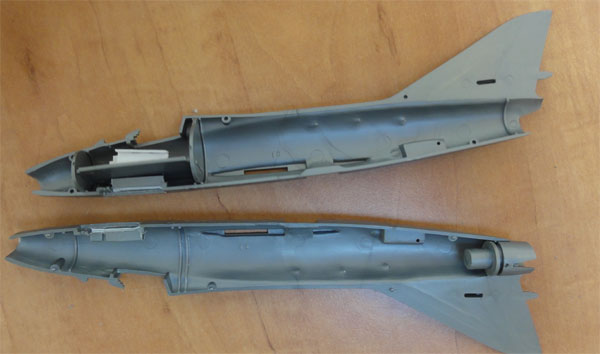
Quickly, the fuselage halves were
glued together. Some clamps were needed.
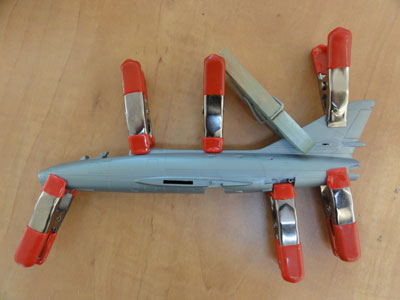
Next came the simple wings, but I
decided to separate and droop/raise the ailerons.
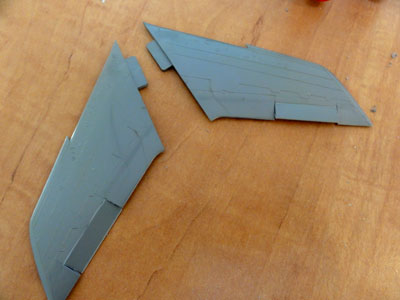
The wing fit to the fuselage was surprisingly
good! This enabled a minimal sanding as I was to retain the raised panel
lines as much as possible.
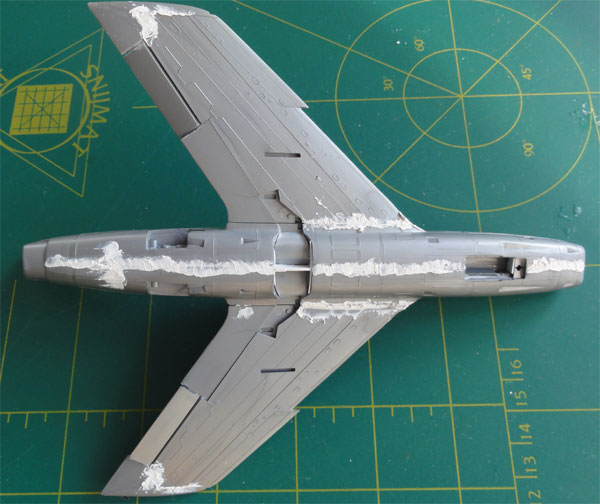

Only filling was needed mostly at
the fuselage joints and minimal sanding is needed. The various smaller
intakes found on the airframe were drilled open with a fine hand drill.
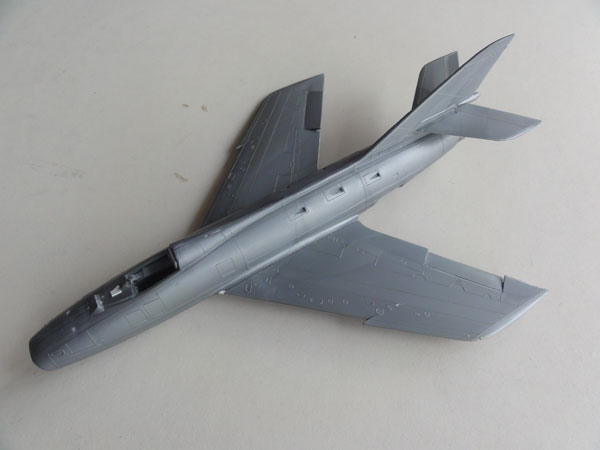
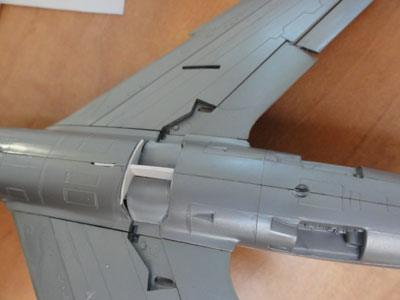
Inside the main gear bay I closed
the sidewalls, only to find out later that was not needed as the
main gear doors are almost always closed with undercarriage out.... So
a bit of time waisted here.
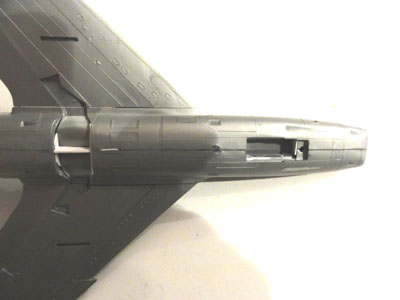
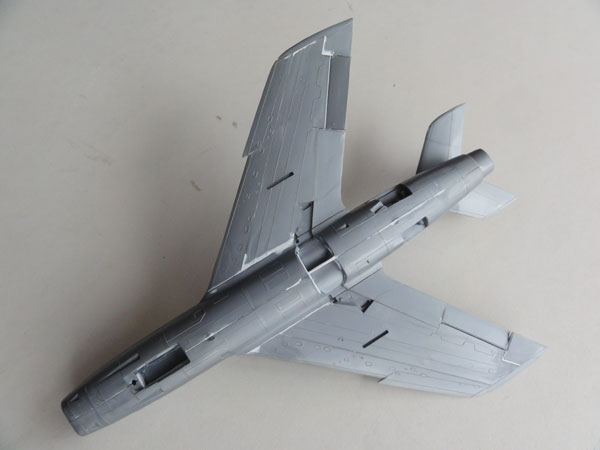
The nose bay wheel well was closed
in as well, which also was not needed as the rear nose wheel doors are
also mostly closed...
The model now got a coat of light grey to checks for any filling errors and irregularities. Some tiny filler corrections were made and the model was ready for another grey base coat.
![]()
Early aircraft delivered by the manufacturer Dassault were I think metallic gloss aluminium (later on in the 1960s the aircraft were probably "painted" in an aluminium paint for easier maintenance).
It was decided to make an early delivered Super Mystere in a metallic gloss aluminium metal scheme. First a couple of grey layers were airbrushed. I did not put on a black gloss undercoat as the model is small and I thought a too gloss sheen would not look realistic.

Over this grey base coat followed a coat of natural metal using ALCLAD
II polished aluminium metallic coat no. 105 using the airbrush
a t a low pressure. When dry, it showed a good sheen.
After drying and some polishing, the
coat is ready glossy to take the decals.
My friend Peter gave me a set of
spare decals from the BERNA 72-52
set with mainly the typical red cheatline.
It has decals for a Armee de L'
Air Super Mystere B2 aircraft from EC 2/10 Seine based at Creil around
1962.
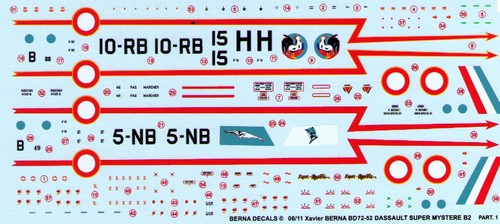
The French roundel replacements came from MODELDECAL sheet 62.
The decals are splendid with I think a correct blue hue of the rudder flag. The model really gets nice while adding the decals. I always "drag each decal" through an amount of Johnson Future . This minimizes "silvering" and helps adhering to the model surface.
The red wing walkway lines were made from cut to size red decal strip from a XTRADECAL set.
![]()
It was now time for detailling and
finishing the Airfix model.
Inside the cockpit , instrument panels were suggested with spare decals. A control stick for the pilot was added as well as a throttle and food pedals from thin card. The cockpit was mostly painted black inside.
The kit seat is very simple, but can
be used to start with. With a TIGER razorsaw the seatpan was cut-in and
this enabled to set a lower seat pan. With some scrap plastic and rod,
details were added. painting was done and straps and belts added made from
tape and coloured decal. The ejection handle was made from thin yellow
electric wire with black stripes painted with a VERY tiny brush.
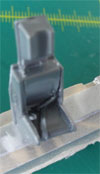 and the result....
and the result.... 
The canopy part 52 was cut in half
with a fine TIGER razorsaw. The rear canopy opens upwards, as seen here:
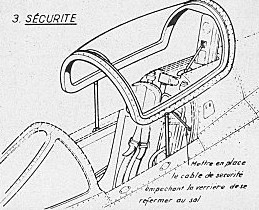 ..
.. ..
..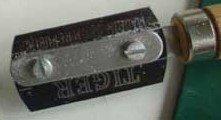
A swivelling bar is at the rear that
fits in a slot aft of the seat. This slot was suggested by painting this
area black on the model. The canopy got some detailling with tiny mirrors
and edges were hand painted in an aluminium colour. The windscreen was
blended in its area with white glue, made flat with a water wetted finger.
Inside the canopy,
I added 2 tiny mirrors cut from thin metallic sheet, glued with super glue.
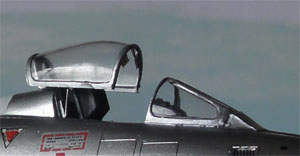 .
. 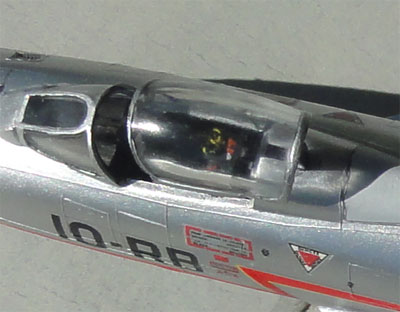
The undercarriage legs anti-torque
bar/ scissors are a bit rough and were cut off. From another kit, a couple
of spare etched metal scissors that were attached with super glue.
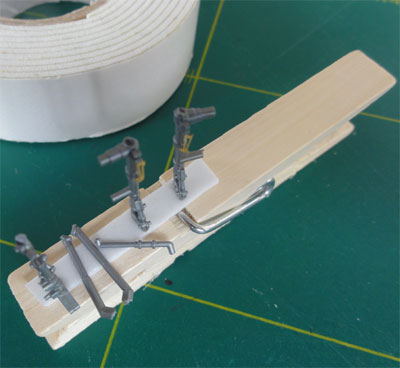
The gear legs were set on the model
and painted metal. Small door retraction rods were added from stretched
sprue. Brake lines were added made from metal wire
on the gear legs.
The main doors do not fit 100%, gaps
were closed with white glue and after drying painted aluminium.
The wheels have brake details on
their outward facing hubs. I used other finer wheels from my spares box
but added the brakes with some card.
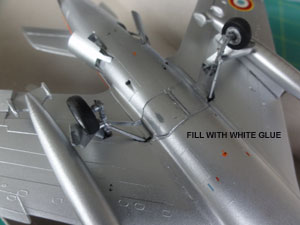 .
. 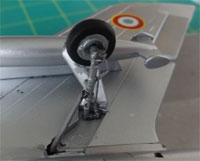
Some panels
(of flaps and elevator) got a wash of tinned black paint to show them.
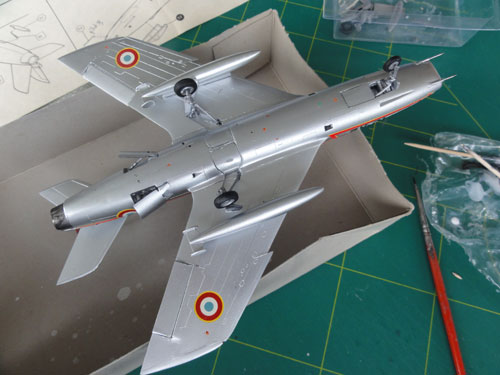
In the wing tips
small notches were cut out for the anti-collision lights. On the left a
red dot, on the right a blue dot was painted and the notches filled with
Microscale
Kristal Clear to get suggestions of "lights".
Two wings tanks from the kit were added now as well. The opened air brakes that have several rows with holes were added. New nose pitot tubes were added made from metal needles.
Some upper antenna spine panels were painted off-white/light grey as well as the fin tip with a black edge.
Finally the model got a decal protecting coat of Johnson Future with the airbrush.
![]()
So here is the result.....
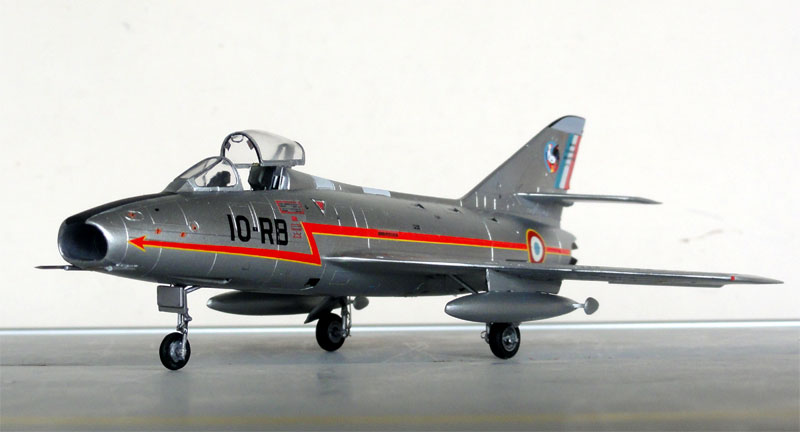
The anti-collision wing tip light
can be seen here clearly
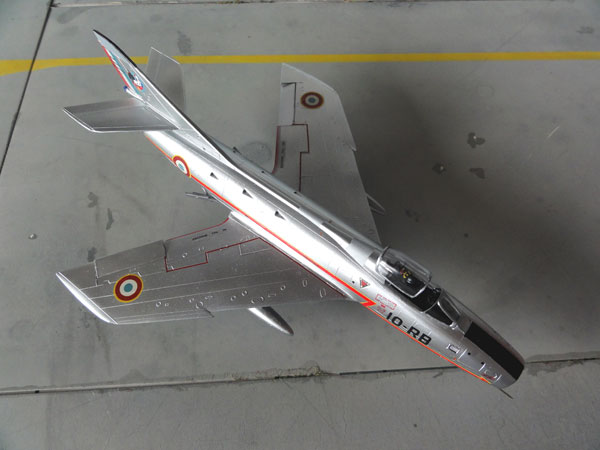
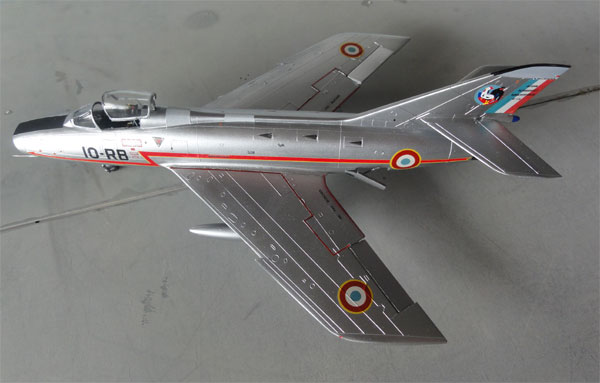

The raised panel lines retained as
on the old Airfix model do not look bad at all I believe.

(click on some of the pictures
for a larger view...)
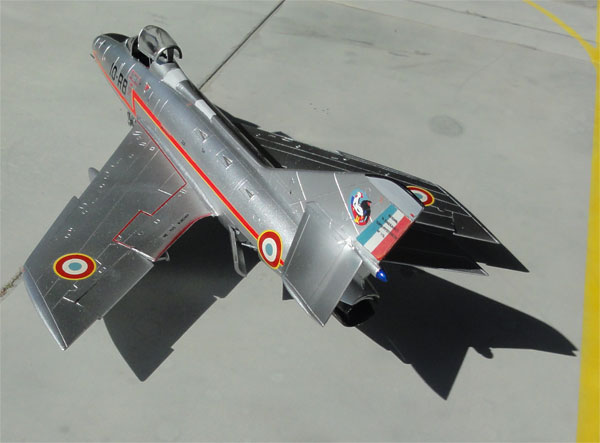
Often, on French aircraft of
the period, bird emblems are shown
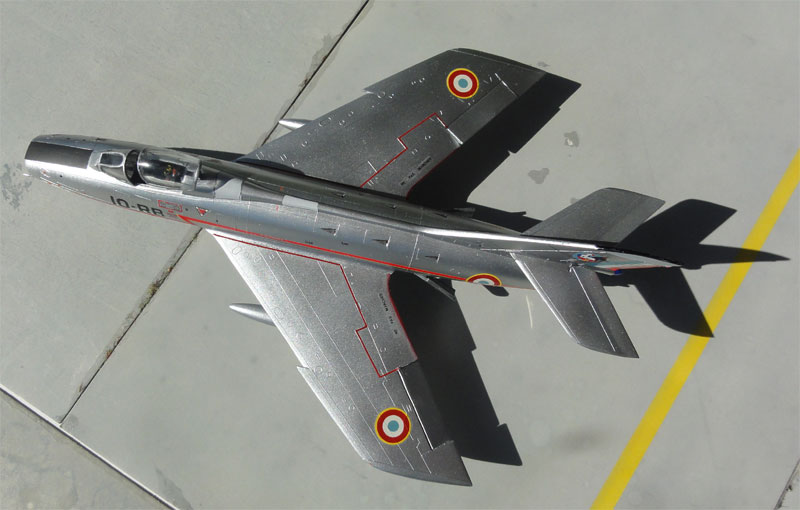
Another nice addition to the Cold War "jet collection" in the 1/72 model collection. Although using the old AIRFIX kit, not bad at all.
On to next [ page 2... ]
References:
- Wings of Fame, Volume 13, pages 30>
- Scale aircraft modelling, January 2019 magazine about Israeli Super Mysteres
- Onze luchtmacht, Dutch magazine, aug/sep 1998 about Honduras air force.
Internet:
- WIKIPEDIA https://en.wikipedia.org/wiki/Dassault_Super_Myst%C3%A8re
- http://www.airvectors.net/avmyst.html
Back to 1/72 Models.......

(c) Copyright Meindert "designer"/ All rights reserved. Your comments are welcomed by webmaster
